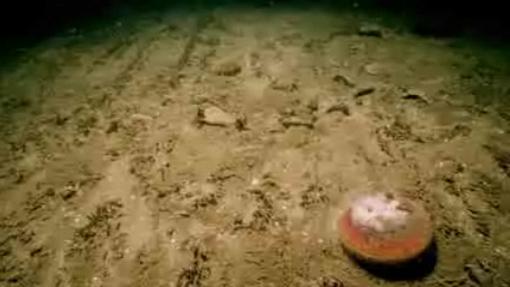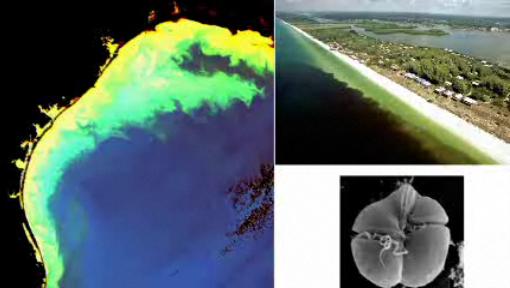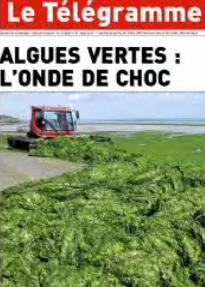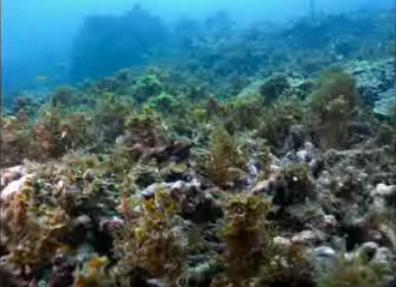06:41 Jeremy JACKSON: How we wrecked the ocean (TED2010) | |
| The other thing is show you is that, although there's this beautiful forest of coral, there're no fish in that picture.Субтитры для презентации на конференции TED2010 о текущем состоянии мирового океана. I'm an ecologist, mostly a coral reef ecologist. I started out in Chesapeake Bay and went diving in the winter and became a tropical ecologist over night. And it was really a lot of fun, for about 10 years. I mean smbd pays you to go around and travel and look at the most beautiful places on the planet. And that was what I did. And I ended up in Jamaica, in the West Indies, where the coral reefs were really among the most extraordinary structurally, that I ever saw in my life. And this picture here, it's really interesting and it shows two things. First of all, it's in black and white, because the water was so clear and you could see so far and film was so slow in the 1960s and the early 70s, you took pictures in black-and-white. The other thing is show you is that, although there's this beautiful forest of coral, there're no fish in that picture. Those reefs at Discovery Bay Jamaica were the most studied coral reefs in the world for 20 years. We were the best and the brightest. People came to study our reefs from Australia, which is sorta funny because now we go to theirs. And the view of scientists about how coral reefs work, how they ought to be, was based on these reefs without any fish. Then in 1980, there was a hurricane, Hurricane Allen. I put half the lab up in my house. The wind blew very strong. The waves're 25 to 50 feet high. And the reefs disappeared, and new islands formed. And we thought: “Well, we're real smart. We know that hurricanes've always happened in the past”. And we publish a paper in Science, the first time that anybody ever described the destruction on a coral reef by a major hurricane. And we predicted what would happen and we got it ALL WRONG. And the reason was because of overfishing, and the fact that a last common-grazer, a sea urchin (морской ёж), died. And withing a few months, after that sea-urching dying, the seaweed (морская водоросль) started to grow. And that is the same reef. That's the same reef 15 years ago. The same reef today. The coral reefs of the north coast of Jamaica have a few percent live coral cover and a lot of seaweed and slime (ил, тина). And that's more or less the story of the coral reefs of the Carribean, and increasingly, tragically, the coral reefs worldwide. Now, that's my little, depressing story. All of us in our 60s and 70s, have comparable depressing stories. There're 10s of 1000s of those stories outthere. And it's really ahrd to conjure up much of sense of well-being, because it just keeps getting worse. And the REASON it keeps getting worse is that after a natural catastrophe, like a hurricane, it USED TO BE that there was some kind of successional sequence of recovery, but what's going on now is that overfishing & pollution & climate change are all interacting in a way that PREVENTS that (recovery). And so I'ma sorta go through and talk about those three kinds of things. OVERFISHINGWe hear a lot about the collapse of cod (треска). It's difficult to imagine that two (or some historians would say three) world wars were fought during the colonial era for the control of cod. Cod fed most of the people of Western Europe. It fed the slaves brough to the Antilles. The sond “Jamaica Farewell” — “Aki rice salt fish are nice” — is an emblem of the importance of salt cod from northeastern Canada. It all collapsed in the 80s and the 90s. 35000 people lost their jobs. And that was the beginning of kinda serial depletion (истощение) from bigger & tastier species to smaller and not-so-tasty species, from species that were near to home, to species that were all around the world, and what have you.It's a little hard to understand that, 'coz you can go to a Costco in the United States and buy cheap fish. You ought to read the label to find out where it came from, but it's still cheap, and everybody thinks it's okay. And it's hard to communicate this. And so, one way that I think is really interesting, is to talk about SPORT FISH, because people like to go out and catch fish. It's one of those things.  This picture here shows the TROPHY FISH — the biggest fish caught by people who pay a lot of money to get on a boat, go to a place off of Key West in Florida, drink a lotta beer, throw a lotta hooks and lines into the water, come back with the biggest and the best fish, and the champion trophy fish are put on this board, where people take a picture, and this guy is obviously really excited about that fish. Well, that's what it's like now, but this is what it was like back in the 1950s.  From the SAME BOAT, in the SAME PLACE, on the SAME BOARD, on the SAME DOCK. And the trophy fish WERE SO BIG, that you couldn't put any of those small fish up on it. And the average size trophy fish weighted 250 to 300 lbs., goliath groper. And if you wanted to go out and kill something, you could pretty much count on being able to catch one of those fish. And they tasted REALLY GOOD. And people paid less in 1950 dollars to catch that, than what people pay now to catch those little, tiny fish. And that's everywhere. It's NOT JUST THE FISH though that are disappearing. Industrial fishing uses big stuff, BIG MACHINERY. We use nets that are 20 MILES LONG. We use long lines that have have one million or TWO MILLION HOOKS. And we trawl (тащить сеть по дну) which means that to take something the size of a TRACTOR TRAILER TRUCK that weights thousands & thousands of pounds, put it on a big chain, and drag it across the sea floor to STIR UP THE BOTTOM and catch the fish. And think of it as being kind of the bulldozing of a city or of a forest, because it CLEARS IT AWAY. And the habitat destruction is unbelievable.  This is a photograph, a TYPICAL PHOTOGRAPH of what continental shelves of the world look like. You can see the ROWS in the bottom, the way you can see the rows in a field that has just been plowed (вспахивать, пахать) to plant corn. What that was, was a FOREST of SPONGES & CORAL, which is a CRITICAL HABITAT for the development of fish. What is now is MUD. And the area of the ocean floor that has been transformed from FOREST to the level MUD, to parking lot, is equivalent to the entire area of all the forests that have ever been cut down on all of the earth in the HISTORY OF HUMANITY. And we've managed to do that in the last 100 to 150 years. POLLUTIONWe tend to think of oil spills and mercury, and we hear a lot of about plastic these days. And all that stuff is really disgusting, but what's really insidious (коварный) is the BIOLOGICAL POLLUTION that happens, because of the magnitude of the shifts that it causes to entire ecosystems. And I'ma just talk very briefly about 2 kinds of biological pollution.One is introduced species, and the other is what comes from nutrients. So this is the infamous caulerpa taxifolia, the so-called KILLER ALGAE (водоросли-убийцы). A book was written about it. It's a bit of an embarrassment. It was ACCIDENTALLY RELEASED from the aquarium in Monaco. It was bred (выводить, разводить) to be COLD TOLERANT, to have in peoples aquaria. It's very pretty, and it has rapidly started to OVERGROW the once-very-rich biodiversity of the northwestern Mediterranean. I dunno how many of you remember the movie “The Little Shop of Horrors,” but this is the plant of “The Little Shop of Horrors”. But instead of devouring (уничтожать) the people in the shop, what it's doing is overgrowing and smothering virtually ALL OF THE BOTTOM-DWELLING LIFE of the entire northwestern Mediterranean Sea. We don't know anything that eats it. We're trying to do all sorts of genetics and figure out something that could be done, but AS IT STANDS, it's the MONSTER from HELL, about which nobody knows what to do. Now, another form of pollution that's biological pollution is what happens from EXCESS NUTRIENTS. The green revolution, all of this ARTIFICIAL NITROGEN FERTILIZER, we used too much of it. It's subsidized, which is one of the reasons we used too much of it. It RUNS DOWN the RIVERS, and it FEEDS the PLANKTON, the little microscopic plant cells in the coastral water. But since we ate all the oysters, and we ate all the fish that would eat the plankton, there's nothing to eat the plankton. And there's more&more of it, so it DIES of OLD AGE, which is UNHEARD OF for plankton. And when it dies, it falls to the bottom and then it rots (гнить, разлагаться), which means that bacteria break it down.  And in the process, they use up ALL THE OXYGEN. And in using all the oxygen they make the environment UTTERLY LETHAL for anything that can't swim away. And so what we end up with, is a MICROBIAL ZOO, dominated by bacteria and jelly-fish. And the only fishery left, and it is a commercial fishery, is the jelly-fish fishery, where used to be prawns (креветка). Even in Newfoundland, where we used to catch cod, we now have a jellyfish fishery. And another version of this sort of thing is what is often called RED TIDES or TOXIC BLOOMS.  That picture is just staggering to me. I've talked about it a milion times, but it's unbelievable. And in the upper right of that picture on the left, is almost the Mississippi Delta, and the lower left of that picture is the Texas, Mexico border. You're looking at the entire northwestern Gulf of Mexico. You're looking at one toxic dinoflagellate bloom that can kill fish, made by that beautiful, little creature on the lower right. And in the upper right you see this black sort of cloud moving to shore. That's the same species. And as it comes to shore, and the wind blows, and little droplets of the water get into the air, the EMERGENCY ROOMS of all the hospitals fill up with people with acute respiratory distress (острая дыхательная боль). And that's retirement homes on the west coast of Florida. A friend and I did this thing in Hollywood we called Hollywood ocean night. And I was trying to figure out how to explain to actors what's going on. And I said: «So, imagine you're in a movie called “Escape from Malibu” because all the beautiful people have moved to North Dakota, where it's clean and safe. And the only people who're left there are the people who CAN'T AFFORD to move away from the coast, because teh coast, instead of being paradise, is HARMFUL to your health.»  And then this is amazing. It was when I was on holiday last early autumn in France. This is from the coast of Brittany, which is being enveloped (закутывать) in this green, algal slime. The reason that it attracted so much attention, besides the fact that it's disgusting, is that sea BIRDS flying over it are ASPHYXIATED by the smell and DIE, and a FARMER DIED of it, and you can imagine the scandal that happened. And so there's this war between the farmers and the fishermen about it all. And the net result is that the beaches of Brittany have to be bulldozed of this stuff on a regular basis. CLIMATE CHANGEAnd then of course there's climate change, and we all know about climate change. And I guess the iconic figure of it is MELTING of the ICE in the ARCTIC SEA. Think of the thousands and thousands of people who died trying to find the Northwest Passage. Well, the Northwest Passage is already there. I think it's sorta funny, it's on the Siberian coast. May be the Russians will charge tolls (пошлина, сбор). The governments of the world are taking this REALLY SERIOUSLY. The military of the arctic nations is taking it really seriously. For all the DENIAL of CLIMATE CHANGE by government leaders, the C.I.A, and the NAVIES of Norway, and the U.S. and CANADA, whatever, are busily thinking about how they will secure their territory in this inevitability from their point of view. And of course, arctic communities are toast.  The other kinds of effects of climate change — this is CORAL BLEACHING. It's a beautiful picture, right. All that white coral. Except it's supposed to be BROWN. And what happens is that the corals are a symbiosis, and they have these little algal cells, that live inside them. And the algae give the corals sugar, and the corals give the algae nutrients and protection. But when it gets TOO HOT, the algae CAN'T MAKE the SUGAR. The corals say: «You cheated, you didn't pay your rent». They KICK 'em OUT, and then they DIE. Not all of them die; some of them survive. Some more are surviving, but it's really bad news. To try and give you a sense of this, imagine you go camping in July somewhere in Europe or in North America, and you wake up next morning and you look around you, that 80% of the trees, as far as you can see, have dropped their leaves and are standing there NAKED. And you come home and you discover that 80% of all the trees in North America and in Europe have dropped their leaves. And then you read in the paper a few weeks later: «Oh, btw, a quarter of those DIED». Well, that's what happened in the Indian Ocean during the 1998 El Nino, an area vastly greater than the size of North America and Europe, when 80% of all the corals bleached and a quarter of them died.  And then the really scary thing about all of this (the overfishing, the pollution & the cilmate change) is that each thing doesn't happen in VACUUM, but there're these, what we call, POSITIVE FEEDBACKS. The synergies among them that make the whole vastly greater than the sum of the parts. And the great scientific challenge for people like me in thinking about all this, is DO WE KNOW HOW to put Humpty Dumpty (что-то разбитое вдребезги) back together again? I mean, because at this point, we can protect it. But what does that mean? We REALLY DON'T KNOW. So what are the oceans going to be like in 20 or 50 years? Well, there won't be ANY FISH except for MINNOWS (мелкая рыбёшка), and the water will be pretty dirty, and all those kinds of things, and full of mercury, etc, etc. And dead zones will get bigger & bigger, and they'll START to MERGE. And we can imagine something like DEAD-ZONIFICATION of the global, coastal ocean. Then you sure WON"T WANT to EAT FISH that were raised in it, because it would be a kind of gastronomic Russian roulette. Sometimes you have a toxic bloom; sometimes you don't. That doesn't sell. The REALLY SCARY things though are the physical, chemical, oceanographic things that are happening. As the surface of the ocean gets warmer, the water is lighter when it's warmer, it becomes harder & harder to turn the ocean over. We say, it becomes more strongly stratified. The consequence of that is that all those nutrients that fuel the great anchoveta fisheries, the sardines of California, or in Peru, or whatever, those SLOW DOWN, and those fisheries COLLAPSE. And the same time, water from the surface, which is reach in oxygen, DOESN'T MAKE IT DOWN, and the OCEAN TURNS into a DESERT. So the questions is: How are we all going to respond to this? And we can do all sorts of things to fix it, but in the final analysis, the real thing we really need to fix is OURSELVES. It's not about the fish; it's not about the pollution; it's not about the climate change. It's about us, and our greed and our need for growth and our inability to imagine a world which is different from the selfish world we live in today. So the question is: Will we respond to this or not? I'd say that the future of life and the dignity of human beings depends on our doing that. | |
|
| |
| Всего комментариев: 0 | |